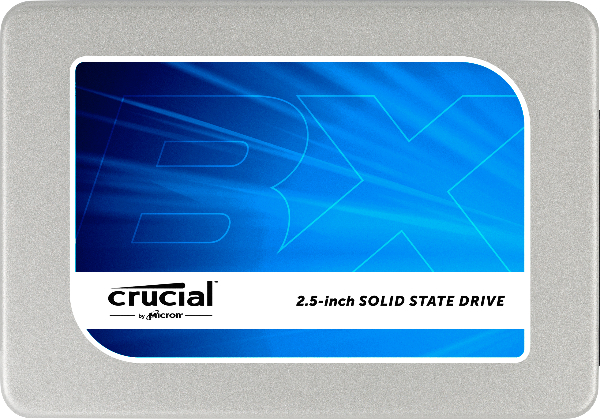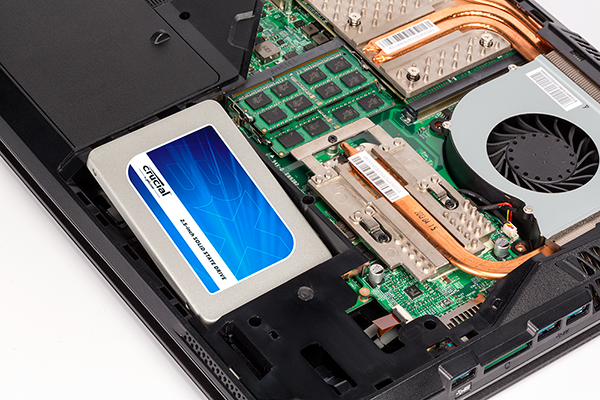Early Verdict
Crucial's BX200 currently suffers too many issues to warrant a recommendation. Just for fun, we went back to the company's C300, the first SATA 6Gb/s solid-state drive to hit the market, as a comparison point. It surfaced in 2010 and obliterated the BX200 in every test we ran. Even the BX100, the BX200's predecessor, is superior in every way.
Pros
- +
The BX200 ships with a nice software package, and aggressive updates could help with performance.
Cons
- -
High latency, high cost, low throughput performance and sequential write performance that is half of a modern mechanical drive.
Why you can trust Tom's Hardware
Specifications, Pricing, Warranty & Accessories
Micron announced its 16nm TLC flash in June 2015, and it's finally ready for prime time. Crucial, a Micron subsidiary, is the first with an SSD based on the new NAND, though the company trails its most notable competition with similar technology. Just because Micron's TLC is only now showing up doesn't mean it's better, though.
For months, rumors swirled about the state of Micron's TLC. When Adata released its SP550 with SK Hynix 16nm TLC memory, we started to wonder if the whispers were true. Now we know. Crucial's BX200 can only claim 66,000 random read IOPS with the new 16nm TLC flash. Adata's 480GB SP550 (its review will go live soon) musters 75,000. And SK Hynix flash is generally slower than everyone else's. We already tested a Longsys Foresee S100 240GB with Toshiba A19 TLC and measured 75,000 random read IOPS. All three drives use the same Silicon Motion SM2256 controller that we previewed a while back. In that article, we achieved 75,000 random read IOPS with older Samsung 19nm TLC flash. Notice a pattern?
This isn't the first time Micron's ONFi-attached flash came up short compared to Toggle-mode NAND from the competition. In fact, the performance gap has grown between the two interfaces since the 2x-nanometer era (2010). But Micron's response typically leads to good results for enthusiasts. You can go back and track large price drops to two events: Black Friday, when SSDs get cheaper and stay that way, and when Micron transitions to a new manufacturing process. The company's triple-level-cell flash is still 16nm. However, 16nm TLC is smaller than an MLC-based die on the same process. I pressed Crucial for specifics, but came up short. It's safest to assume that TLC should be around one-third smaller than MLC.
Specifications



MORE: Best SSDs For The Money
MORE: Latest Storage News
MORE: Storage in the Forums
Crucial's BX series is its entry-level line; for the first time, we heard the company use it in a talk about replacing hard drives with SSDs. The BX200 will succeed the BX100, which is being phased out rapidly. The new entry-level drive will surface in three capacities, starting at 240GB. Crucial no longer feels the 128GB capacity class is realistic for upgrades, since reduced parallelization severely limits performance.
All three BX200s employ Silicon Motion's SM2256 controller. Crucial uses a custom firmware co-developed with SMI. Interestingly, performance is the same across capacities. Sequential reads are rated at 540 MB/s, while writes land at 490 MB/s. Random read IOPS are claimed to be 66,000, while writes jump to 78,000 as a result of the dynamic SLC program cache.
The BX200 supports DevSlp, an ultra-low power mode most useful in the mobile space. These drives can drop to just 10mW and then wake up quickly. Although hardware encryption is not supported, we rarely hear anyone complain about its absence outside of businesses that require it.
Get Tom's Hardware's best news and in-depth reviews, straight to your inbox.
Price & Warranty
In our talks with Micron, we were all but guaranteed the quoted MSRPs wouldn't hold for long. The BX200s are expected to sell for prices comparable with many other well-known SSDs. Getting them to stand out will necessitate heavy cuts in time for Black Friday. As it sits now, the 960GB BX200 should go for $300. The 480GB and 240GB models cost $150 and $85, respectively.
They're all covered by a three-year limited warranty capped at 72 terabytes written. The TBW rating is less than half of what you get from Samsung's 850 EVO.
Accessories
The BX100 didn't come with anything except a 7mm-to-9.5mm adapter. Crucial's BX200 raises the bar, including access to Acronis True Image for cloning existing drives and the company's Storage Executive software (now standard with all Crucial SSDs).
It's hard to believe that Storage Executive exposes so many features, given its relative youth. It was just released last January and is already up to version 3.24. Somewhere along the line, Crucial updated the software with a DRAM cache function called Momentum Cache, similar to Samsung's Rapid Mode and Plextor's PlexTurbo. This is what Crucial says about the feature:
Micron's Momentum Cache is an intelligent software driver that dynamically leverages unused system resources to enhance burst performance on supported Micron and Crucial solid-state drives (SSDs) in Windows operating systems. Momentum Cache is not restricted by SATA bus throughput limitations; instead, it uses additional DRAM bandwidth to achieve increased burst performance.
A new feature for version 3.24 lets you configure over-provisioning for enhanced endurance and performance. With more space reserved, random write performance increases. Endurance improves as well due to better flash management. Latency may even drop under the right conditions.

Chris Ramseyer was a senior contributing editor for Tom's Hardware. He tested and reviewed consumer storage.
-
SylentVyper These drives better come in a decent amount under the suggested price. The 850 Evo is constantly hitting those price points (or less) and prices have only been dropping. The 850 Evo is slightly faster on the sequential side, but far better with random read/write IOPS. You also get a better warranty, too.Reply -
mapesdhs Atm I don't see any reason to buy anything other than the 850 EVO atm in that budget range, they are priced so well. Bought a 250GB this week for my brother, it was only 63 UKP total from Amazon. Bought two 500GB units for myself for 117 each. Other vendors will have to move a lot in order to compete even on price, never mind performance & warranty.Reply
-
AndrewJacksonZA Did you duplicate the latency histogram pie charts for the BX200 960GB and the BX100 500GB? They're exactly the same.Reply
Thanks -
daglesj I love it when a manufacturer replaces a older model with a model that performs far worse. Time to snap up those excellent BX100's on clearance sales! How do companies screw up like this? Doesn't anyone do product testing and benchmarking before release anymore?Reply -
nforce4max I for once I almost no interest in current generation SSDs as I do not like TLC nand and not impressed with the performance in general. Just something to avoid when buying SSDs especially when it comes to the cheaper low capacity models for my projects. Last thing that I need is having to re-write everything every few months or suffer spinner level or worse performance (problem with planar TLC nand).Reply
For those who have been out of the loop or haven't bough their first SSD yet just avoid SSDs that use TLC unless it is 3D (stacked) and just pay a little more for MLC. -
Chris Droste Kinda Ridiculous when you can get the MX100 512GB w/ MLC NAND for $149. unless they're planning on making the 480gig a sub-$100 drive by the holidays this is a non-starter.Reply -
CRamseyer ReplyDid you duplicate the latency histogram pie charts for the BX200 960GB and the BX100 500GB? They're exactly the same.
Thanks
It's not a duplicate. The latency distribution is just the same for both. I'm working on fine tuning those charts a bit.
Also, you will notice that the bars on the side are different sizes even though it's still 0%. Data has fallen into those buckets but not more than 1%.
-
George Phillips Crucial's products are usually good, pretty fast, and very reliable. This one is an exception.Reply
